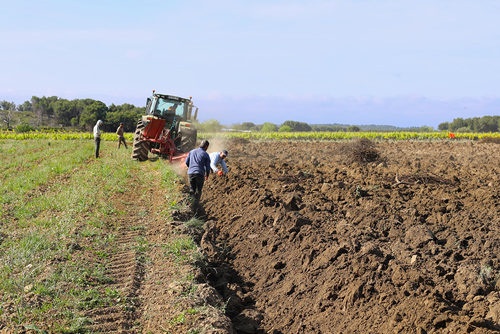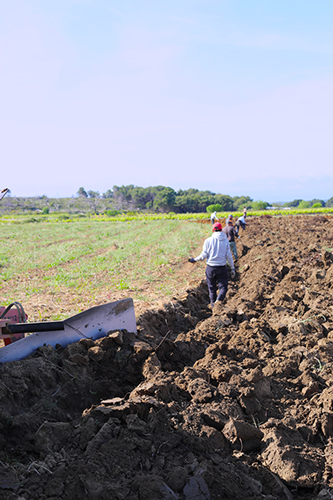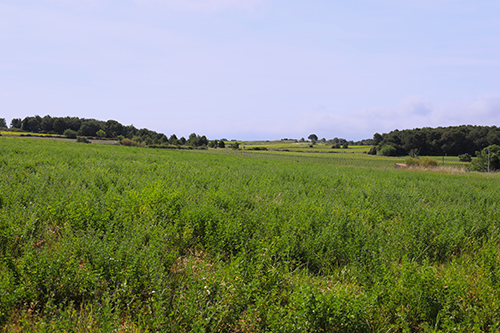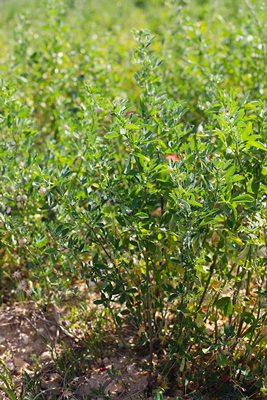THE PLOUGHING or RIPPING
If the name of the technique sounds rough, its usefulness is not. The ploughing is an essential labor for the quality of the wine. It is a traditional cultivation technique used in vineyards for centuries. If some modern winegrowers do without it, at Domaines Paul Mas, we know that if we want the vines to healthily age, this step is essential!
When the vines get too old, they may begin to produce lower quality and/or fewer grapes. This is because aging vines have a reduced ability to absorb the water and nutrients needed to produce quality grapes. In addition, these vines are often more prone to disease and pest attacks.
It is therefore necessary to replace aging vines with new ones to maintain the quality and quantity of grape production. At Domaines Paul Mas, approximately 60 hectares are permanently fallow land.
Ploughing consists of plowing the land between the rows of vines that have been pulled out with a plow, to turn it over and aerate it. But what is the purpose of this practice? Why is it so important for the quality of the wine? Here’s everything you need to know about vineyard’s ploughing.
Why plough once the vines have been pulled out?
The ripping or ploughing of uprooted vines consists in ploughing the ground between the rows of vines after having uprooted the stocks. This technique allows to break the clods of earth and to bury them in the ground to facilitate the circulation of water and air. It also eliminates weeds and promotes the growth of future vine plants. But above all, by ploughing the soil, it allows to bring up the roots of the vine which has just been pulled out.
Benefits of plowing up uprooted vines
- Improved soil structure: Ploughing breaks up clumps of soil, aerating and mixing them, improving soil structure, and promoting root penetration.
- Weed control: By tilling the soil, plowing eliminates weeds that compete with grapevines for nutrients and water.
- Preparation for replanting: Ploughing prepares the soil for replanting new vines. By removing old vines, it prepares the soil for future roots.
The benefits of ploughing for the quality of the wine
Ploughing is a practice that may seem trivial, but it has a significant impact on the quality of the wine. By eliminating the dead roots, we avoid the birth of diseases, and we help the future vine roots’ to have the space under the ground necessary for their good development, which allows the vine to express itself better and to produce grapes of superior quality.
By choosing to practice ploughing, we opt for a reasoned agriculture and respect for the environment, while guaranteeing the quality of our production.
How is ploughing done?
The ploughing is done with the help of a plough, an agricultural machine that ploughs the earth, making trenches of about 50cm. Our vineyard worker will then pick up by hand and pile up all the roots. The ploughing requires a lot of work.
Once the roots are piled up, they will be burned.
The soil is then ready and left to rest. The vine begins its fallow period.
Fallow land
Fallowing is an agricultural technique that consists of leaving a piece of land uncultivated for a given period. This technique has been used for centuries to improve soil health and increase the fertility of the land.
It has many advantages. First, it regenerates the soil by allowing the land to rest for some time. The soil is nourished by the residues of the previous crop and can recover the needed nutrients for the future growth of vines. Fallowing can also improve soil structure, making it easier for grapevines to root and grow.
It is also important to choose the right plants to grow during fallow. These plants will help reduce weeds and maintain soil structure. At Domaines Paul Mas, our vineyard manager has chosen alfalfa, a crop of choice, offering a multitude of benefits.
What is alfalfa?
Alfalfa (Medicago sativa) is a perennial herbaceous plant belonging to the legume family. It is widely cultivated for forage, as it is rich in protein and nutrients. Alfalfa is also used as a cover crop in agriculture to improve soil quality. The plant can fix atmospheric nitrogen through symbiosis with bacteria in its roots, making it a crop of choice for grape growers seeking to maintain soil fertility.
The fallow period must be planned to allow the vines to recover quickly once the fallow is over. We leave our vines fallow for 5 years.




